wheel MAZDA MODEL 3 HATCHBACK 2006 (in English) Workshop Manual
[x] Cancel search | Manufacturer: MAZDA, Model Year: 2006, Model line: MODEL 3 HATCHBACK, Model: MAZDA MODEL 3 HATCHBACK 2006Pages: 372, PDF Size: 5.55 MB
Page 311 of 372

Black plate (311,1)
qRepairing Damage to the Finish
Deep scratches or chips on the finish
should be repaired promptly. Exposed
metal quickly rusts and can lead to major
repairs.
CAUTION
If your Mazda is damaged and needs
metal parts repaired or replaced, make
sure the body shop applies anti-
corrosion materials to all parts, both
repaired and new. This will prevent
them from rusting.
qBright-Metal Maintenance
lUse tar remover to remove road tar and
insects. Never do this with a knife or
similar tool.
lTo prevent corrosion on bright-metal
surfaces, apply wax or chrome
preservative and rub it to a high luster.
lDuring cold weather or in coastal areas,
cover bright-metal parts with a coating
of wax or preservative heavier than
usual. It would also help to coat them
with noncorrosive petroleum jelly or
some other protective compound.
CAUTION
Don't use steel wool, abrasive cleaners,
or strong detergents containing highly
alkaline or caustic agents on chrome-
plated or anodized aluminum parts.
This may result in damage to the
protective coating and cause
discoloration or paint deterioration.
qUnderbody Maintenance
Road chemicals and salt used for ice and
snow removal and solvents used for dust
control may collect on the underbody. If
not removed, they will speed up rusting
and deterioration of such underbody parts
as fuel lines, frame, floor pan, and exhaust
system, even though these parts may be
coated with anti-corrosive material.
Thoroughly flush the underbody and
wheel housings with lukewarm or cold
water at the end of each winter. Try also
to do this every month.
Pay special attention to these areas
because they easily hide mud and dirt.It
will do more harm than good to wet
down the road grime without removing
it.
The lower edges of doors, rocker panels,
and frame members have drain holes that
should not be clogged. Water trapped
there will cause rusting.
WARNING
Driving with Wet Brakes:
Driving with wet brakes is dangerous.
Increased stopping distance or the
vehicle pulling to one side when
braking could result in a serious
accident. Light braking will indicate
whether the brakes have been affected.
Dry the brakes by driving very slowly
and applying the brakes lightly until
brake performance is normal.
Maintenance and Care
Appearance Care
8-63
Mazda3_8U55-EA-05G_Edition2 Page311
Thursday, June 23 2005 2:56 PM
Form No.8U55-EA-05G
Page 312 of 372

Black plate (312,1)
qAluminum Wheel Maintenance
A protective coating is provided over the
aluminum wheels. Special care is needed
to protect this coating.
NOTE
lDon't use a wire brush or any
abrasive cleaner, polishing
compound, or solvent on aluminum
wheels. They may damage the
coating.
lOnly use a mild soap or neutral
detergent and always use a sponge or
soft cloth to clean the wheels.
Rinse thoroughly with lukewarm or
cold water. Also, be sure to clean the
wheels after driving on dusty or
salted roads. This helps prevent
corrosion.
lAvoid washing your vehicle in an
automatic car wash that uses high-
speed or hard brushes.
lIf your aluminum wheels lose luster,
wax the wheels.
Interior Care
qDashboard Precautions
Prevent caustic solutions such as perfume
and cosmetic oils from contacting the
dashboard. They'll damage and discolor it.
If these solutions get on the dashboard,
wipe them off immediately.
CAUTION
Do not use glazing agents.
Glazing agents contain ingredients
which may cause discoloration,
wrinkling, cracks and peeling.
qCleaning the Upholstery and
Interior Trim
Vinyl
Remove dust and loose dirt from vinyl
with a whisk broom or vacuum cleaner.
Clean vinyl with a leather-and-vinyl
cleaner.
Leatherí
Real leather isn't uniform and may have
scars, scratches, and wrinkles. Clean it
with a leather cleaner or mild soap.
Wipe it with adampsoft cloth; then dry
and buff it with adrysoft cloth.
Fabric
Remove dust and loose dirt from fabric
with a whisk broom or vacuum cleaner.
Clean it with a mild soap solution good
for upholstery and carpets. Remove fresh
spots immediately with a fabric spot
cleaner.
8-64
Maintenance and Care
íSome models.
Appearance Care
Mazda3_8U55-EA-05G_Edition2 Page312
Thursday, June 23 2005 2:56 PM
Form No.8U55-EA-05G
Page 313 of 372

Black plate (313,1)
To keep the fabric looking clean and
fresh, take care of it. Otherwise its color
will be affected, it can be stained easily,
and its fire-resistance may be reduced.
CAUTION
Use only recommended cleaners and
procedures. Others may affect
appearance and fire-resistance.
Piano black panelí
The following parts are fitted with panels
that have been treated with a special
coating that resists scratching.
lInstrument panel side garnish
lSteering wheel (partial)
When the panel needs to be cleaned, use a
soft cloth to wipe off dirt from the surface.
NOTE
Scratches or nicks on the panels
resulting from the use of a hard brush or
cloth may not be repairable.
qCleaning the Lap/Shoulder Belt
Webbing
Clean the webbing with a mild soap
solution recommended for upholstery or
carpets. Follow instructions. Don't bleach
or dye the webbing; this may weaken it.
After cleaning the belts, thoroughly dry
the belt webbing and make sure there is
no remaining moisture before retracting
them.
WARNING
Damaged Seat Belt:
Using damaged seat belts is
dangerous. In a collision, damaged
belts cannot provide adequate
protection. Have an Authorized Mazda
Dealer replace damaged belts
immediately.
qCleaning the Window Interiors
If the windows become covered with an
oily, greasy, or waxy film, clean them
with glass cleaner. Follow the directions
on the container.
CAUTION
Don't scrape or scratch the inside of the
rear window. You may damage the rear
window defroster grid.
Maintenance and Care
Appearance Care
8-65íSome models. Mazda3_8U55-EA-05G_Edition2 Page313
Thursday, June 23 2005 2:56 PM
Form No.8U55-EA-05G
Page 333 of 372
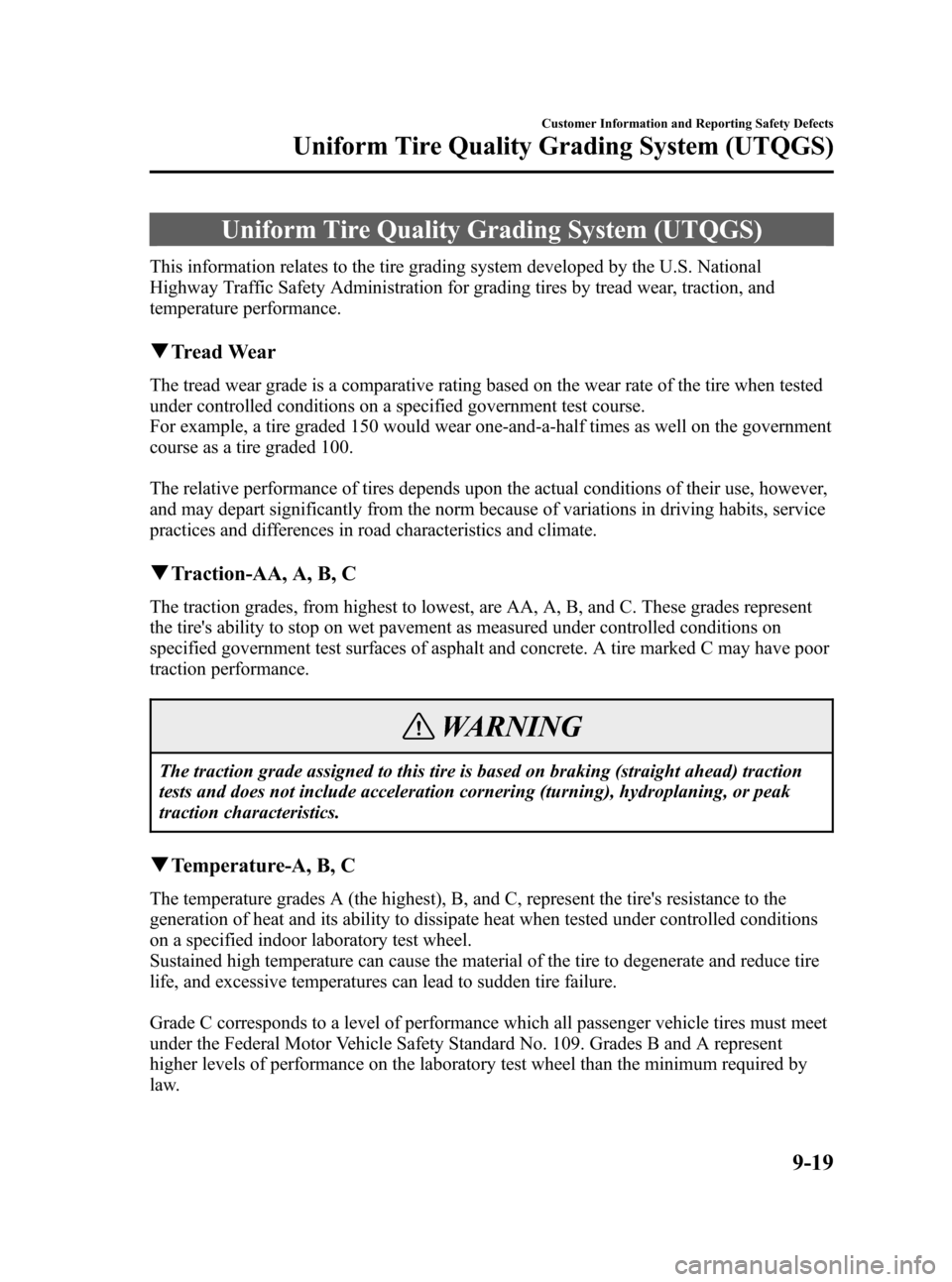
Black plate (333,1)
Uniform Tire Quality Grading System (UTQGS)
This information relates to the tire grading system developed by the U.S. National
Highway Traffic Safety Administration for grading tires by tread wear, traction, and
temperature performance.
qTread Wear
The tread wear grade is a comparative rating based on the wear rate of the tire when tested
under controlled conditions on a specified government test course.
For example, a tire graded 150 would wear one-and-a-half times as well on the government
course as a tire graded 100.
The relative performance of tires depends upon the actual conditions of their use, however,
and may depart significantly from the norm because of variations in driving habits, service
practices and differences in road characteristics and climate.
qTraction-AA, A, B, C
The traction grades, from highest to lowest, are AA, A, B, and C. These grades represent
the tire's ability to stop on wet pavement as measured under controlled conditions on
specified government test surfaces of asphalt and concrete. A tire marked C may have poor
traction performance.
WARNING
The traction grade assigned to this tire is based on braking (straight ahead) traction
tests and does not include acceleration cornering (turning), hydroplaning, or peak
traction characteristics.
qTemperature-A, B, C
The temperature grades A (the highest), B, and C, represent the tire's resistance to the
generation of heat and its ability to dissipate heat when tested under controlled conditions
on a specified indoor laboratory test wheel.
Sustained high temperature can cause the material of the tire to degenerate and reduce tire
life, and excessive temperatures can lead to sudden tire failure.
Grade C corresponds to a level of performance which all passenger vehicle tires must meet
under the Federal Motor Vehicle Safety Standard No. 109. Grades B and A represent
higher levels of performance on the laboratory test wheel than the minimum required by
law.
Customer Information and Reporting Safety Defects
Uniform Tire Quality Grading System (UTQGS)
9-19
Mazda3_8U55-EA-05G_Edition2 Page333
Thursday, June 23 2005 2:56 PM
Form No.8U55-EA-05G
Page 336 of 372
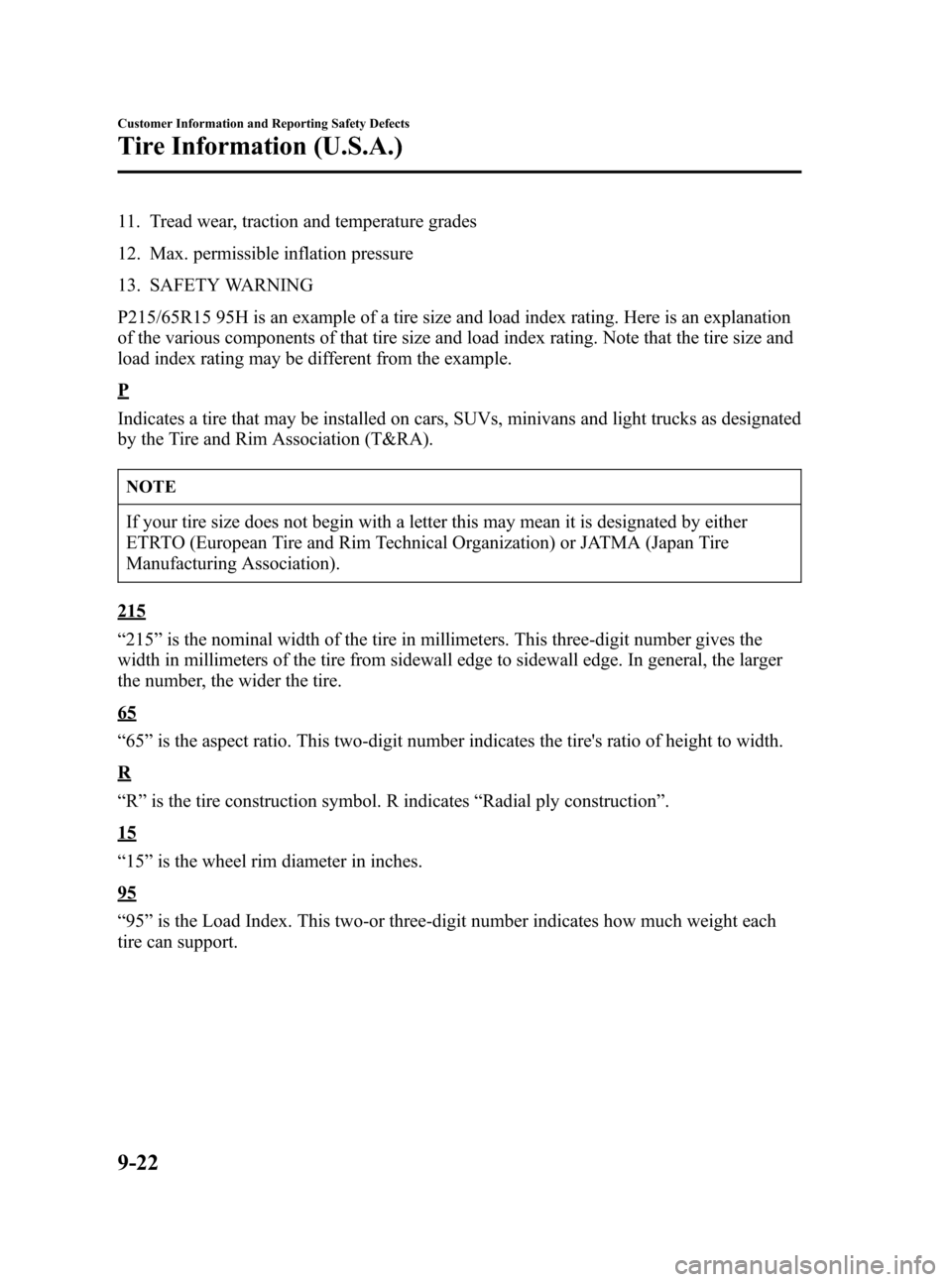
Black plate (336,1)
11. Tread wear, traction and temperature grades
12. Max. permissible inflation pressure
13. SAFETY WARNING
P215/65R15 95H is an example of a tire size and load index rating. Here is an explanation
of the various components of that tire size and load index rating. Note that the tire size and
load index rating may be different from the example.
P
Indicates a tire that may be installed on cars, SUVs, minivans and light trucks as designated
by the Tire and Rim Association (T&RA).
NOTE
If your tire size does not begin with a letter this may mean it is designated by either
ETRTO (European Tire and Rim Technical Organization) or JATMA (Japan Tire
Manufacturing Association).
215
“215”is the nominal width of the tire in millimeters. This three-digit number gives the
width in millimeters of the tire from sidewall edge to sidewall edge. In general, the larger
the number, the wider the tire.
65
“65”is the aspect ratio. This two-digit number indicates the tire's ratio of height to width.
R
“R”is the tire construction symbol. R indicates“Radial ply construction”.
15
“15”is the wheel rim diameter in inches.
95
“95”is the Load Index. This two-or three-digit number indicates how much weight each
tire can support.
9-22
Customer Information and Reporting Safety Defects
Tire Information (U.S.A.)
Mazda3_8U55-EA-05G_Edition2 Page336
Thursday, June 23 2005 2:56 PM
Form No.8U55-EA-05G
Page 338 of 372
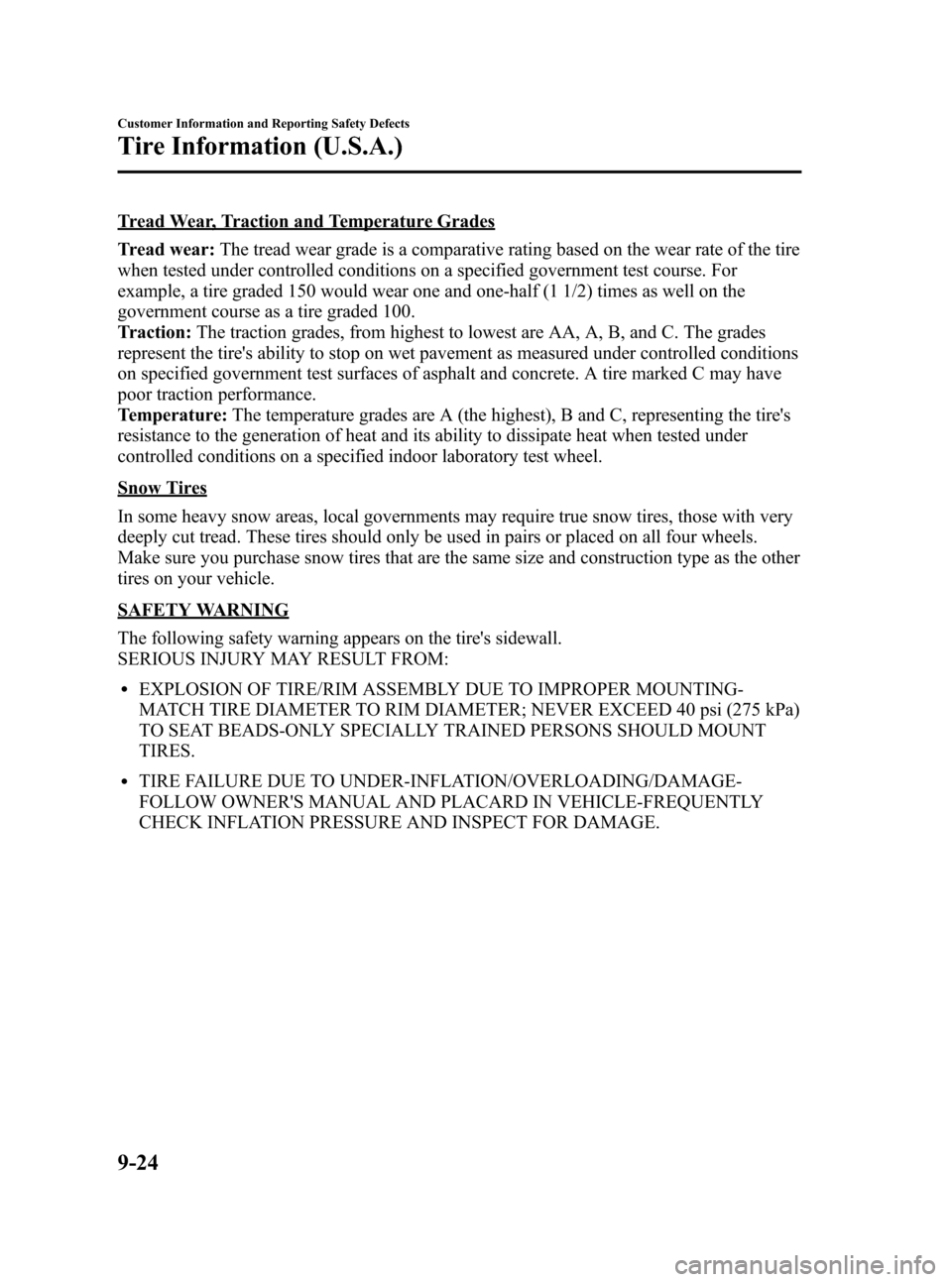
Black plate (338,1)
Tread Wear, Traction and Temperature Grades
Tread wear:The tread wear grade is a comparative rating based on the wear rate of the tire
when tested under controlled conditions on a specified government test course. For
example, a tire graded 150 would wear one and one-half (1 1/2) times as well on the
government course as a tire graded 100.
Traction:The traction grades, from highest to lowest are AA, A, B, and C. The grades
represent the tire's ability to stop on wet pavement as measured under controlled conditions
on specified government test surfaces of asphalt and concrete. A tire marked C may have
poor traction performance.
Temperature:The temperature grades are A (the highest), B and C, representing the tire's
resistance to the generation of heat and its ability to dissipate heat when tested under
controlled conditions on a specified indoor laboratory test wheel.
Snow Tires
In some heavy snow areas, local governments may require true snow tires, those with very
deeply cut tread. These tires should only be used in pairs or placed on all four wheels.
Make sure you purchase snow tires that are the same size and construction type as the other
tires on your vehicle.
SAFETY WARNING
The following safety warning appears on the tire's sidewall.
SERIOUS INJURY MAY RESULT FROM:
lEXPLOSION OF TIRE/RIM ASSEMBLY DUE TO IMPROPER MOUNTING-
MATCH TIRE DIAMETER TO RIM DIAMETER; NEVER EXCEED 40 psi (275 kPa)
TO SEAT BEADS-ONLY SPECIALLY TRAINED PERSONS SHOULD MOUNT
TIRES.
lTIRE FAILURE DUE TO UNDER-INFLATION/OVERLOADING/DAMAGE-
FOLLOW OWNER'S MANUAL AND PLACARD IN VEHICLE-FREQUENTLY
CHECK INFLATION PRESSURE AND INSPECT FOR DAMAGE.
9-24
Customer Information and Reporting Safety Defects
Tire Information (U.S.A.)
Mazda3_8U55-EA-05G_Edition2 Page338
Thursday, June 23 2005 2:56 PM
Form No.8U55-EA-05G
Page 340 of 372

Black plate (340,1)
D
“D”is the tire construction symbol. D indicates“diagonal ply construction”.
16
“16”is the wheel rim diameter in inches.
9-26
Customer Information and Reporting Safety Defects
Tire Information (U.S.A.)
Mazda3_8U55-EA-05G_Edition2 Page340
Thursday, June 23 2005 2:56 PM
Form No.8U55-EA-05G
Page 343 of 372
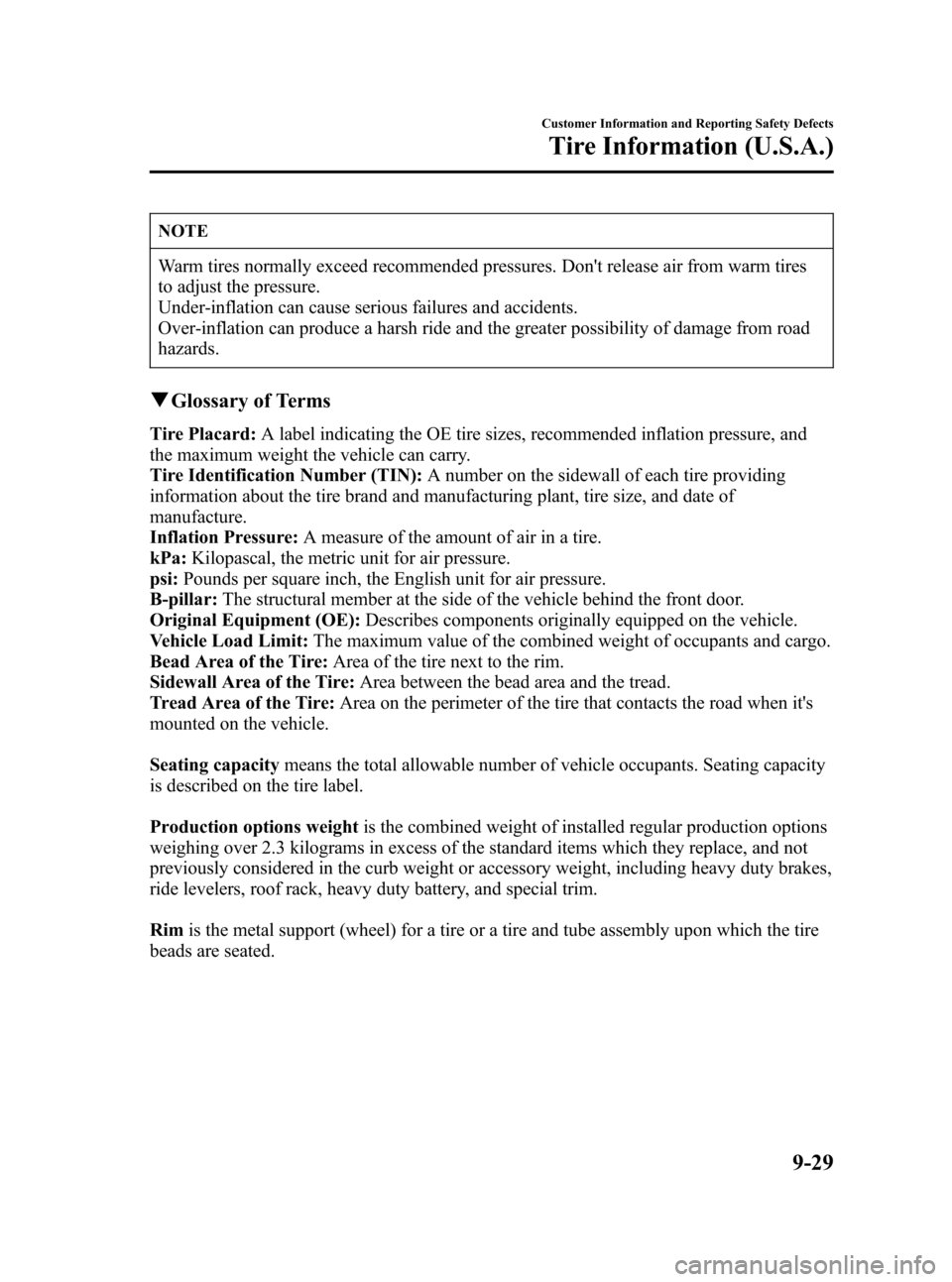
Black plate (343,1)
NOTE
Warm tires normally exceed recommended pressures. Don't release air from warm tires
to adjust the pressure.
Under-inflation can cause serious failures and accidents.
Over-inflation can produce a harsh ride and the greater possibility of damage from road
hazards.
qGlossary of Terms
Tire Placard:A label indicating the OE tire sizes, recommended inflation pressure, and
the maximum weight the vehicle can carry.
Tire Identification Number (TIN):A number on the sidewall of each tire providing
information about the tire brand and manufacturing plant, tire size, and date of
manufacture.
Inflation Pressure:A measure of the amount of air in a tire.
kPa:Kilopascal, the metric unit for air pressure.
psi:Pounds per square inch, the English unit for air pressure.
B-pillar:The structural member at the side of the vehicle behind the front door.
Original Equipment (OE):Describes components originally equipped on the vehicle.
Vehicle Load Limit:The maximum value of the combined weight of occupants and cargo.
Bead Area of the Tire:Area of the tire next to the rim.
Sidewall Area of the Tire:Area between the bead area and the tread.
Tread Area of the Tire:Area on the perimeter of the tire that contacts the road when it's
mounted on the vehicle.
Seating capacitymeans the total allowable number of vehicle occupants. Seating capacity
is described on the tire label.
Production options weightis the combined weight of installed regular production options
weighing over 2.3 kilograms in excess of the standard items which they replace, and not
previously considered in the curb weight or accessory weight, including heavy duty brakes,
ride levelers, roof rack, heavy duty battery, and special trim.
Rimis the metal support (wheel) for a tire or a tire and tube assembly upon which the tire
beads are seated.
Customer Information and Reporting Safety Defects
Tire Information (U.S.A.)
9-29
Mazda3_8U55-EA-05G_Edition2 Page343
Thursday, June 23 2005 2:56 PM
Form No.8U55-EA-05G
Page 344 of 372
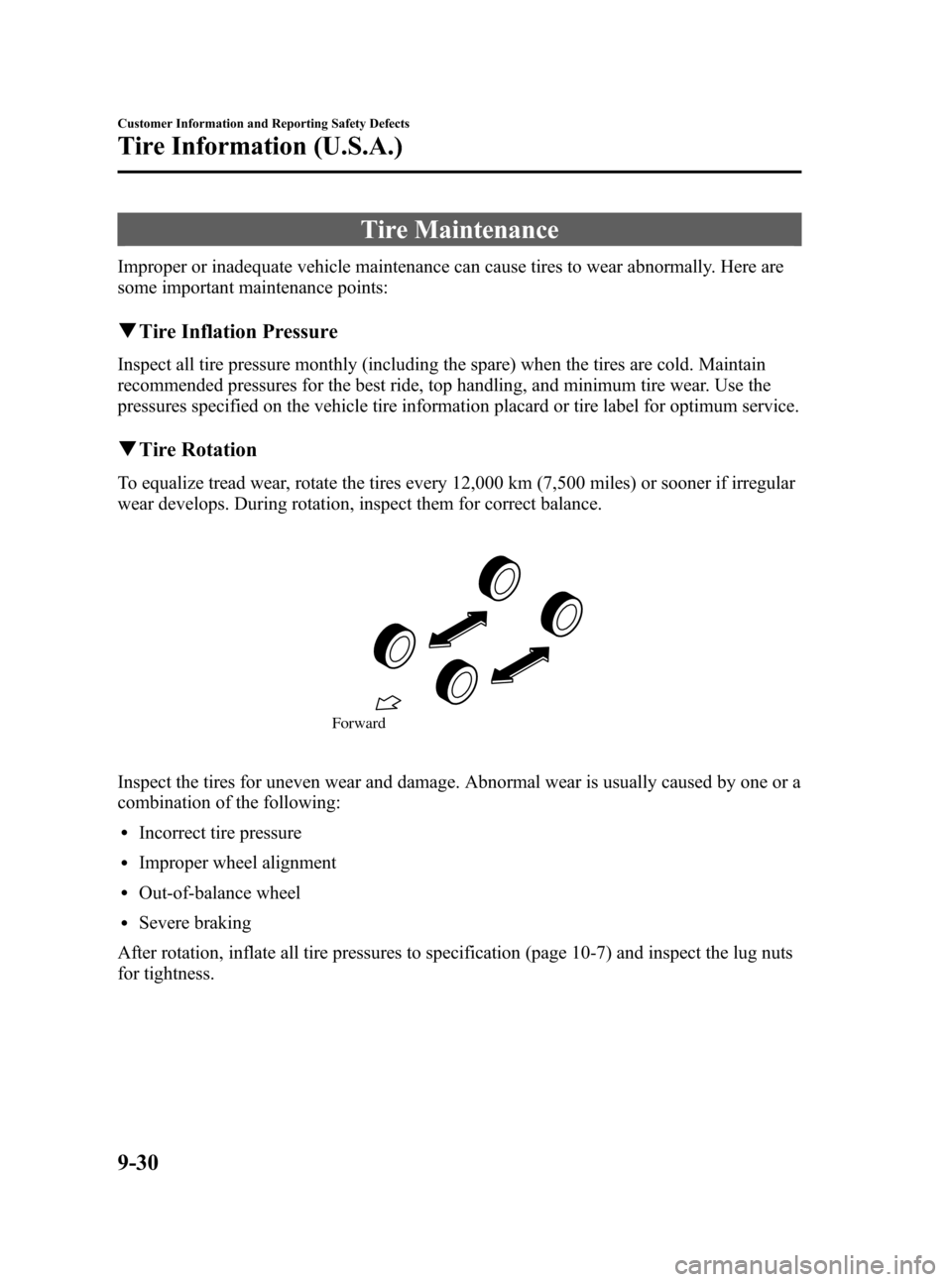
Black plate (344,1)
Tire Maintenance
Improper or inadequate vehicle maintenance can cause tires to wear abnormally. Here are
some important maintenance points:
qTire Inflation Pressure
Inspect all tire pressure monthly (including the spare) when the tires are cold. Maintain
recommended pressures for the best ride, top handling, and minimum tire wear. Use the
pressures specified on the vehicle tire information placard or tire label for optimum service.
qTire Rotation
To equalize tread wear, rotate the tires every 12,000 km (7,500 miles) or sooner if irregular
wear develops. During rotation, inspect them for correct balance.
Forward
Inspect the tires for uneven wear and damage. Abnormal wear is usually caused by one or a
combination of the following:
lIncorrect tire pressure
lImproper wheel alignment
lOut-of-balance wheel
lSevere braking
After rotation, inflate all tire pressures to specification (page 10-7) and inspect the lug nuts
for tightness.
9-30
Customer Information and Reporting Safety Defects
Tire Information (U.S.A.)
Mazda3_8U55-EA-05G_Edition2 Page344
Thursday, June 23 2005 2:56 PM
Form No.8U55-EA-05G
Page 345 of 372
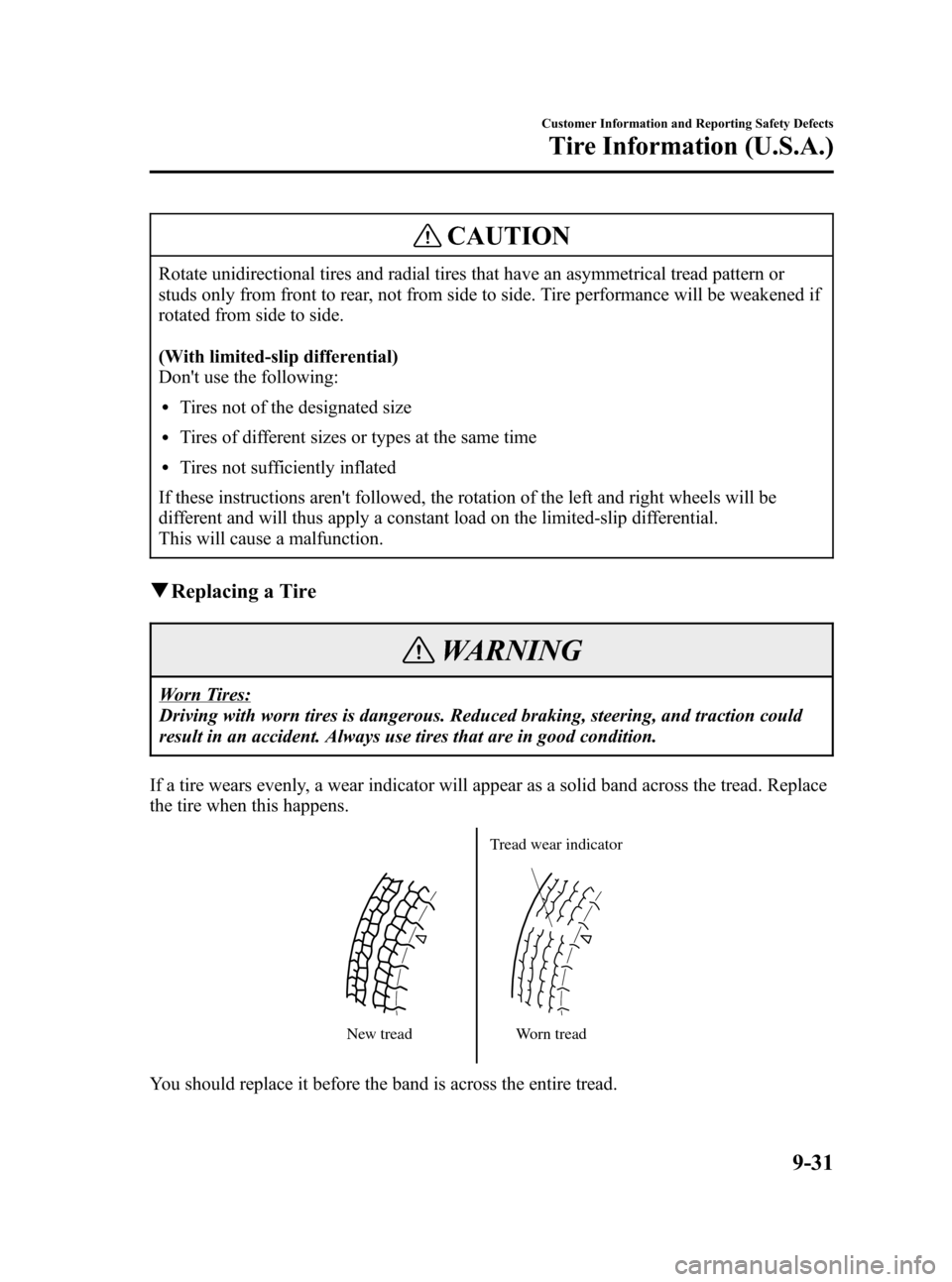
Black plate (345,1)
CAUTION
Rotate unidirectional tires and radial tires that have an asymmetrical tread pattern or
studs only from front to rear, not from side to side. Tire performance will be weakened if
rotated from side to side.
(With limited-slip differential)
Don't use the following:
lTires not of the designated size
lTires of different sizes or types at the same time
lTires not sufficiently inflated
If these instructions aren't followed, the rotation of the left and right wheels will be
different and will thus apply a constant load on the limited-slip differential.
This will cause a malfunction.
qReplacing a Tire
WARNING
Worn Tires:
Driving with worn tires is dangerous. Reduced braking, steering, and traction could
result in an accident. Always use tires that are in good condition.
If a tire wears evenly, a wear indicator will appear as a solid band across the tread. Replace
the tire when this happens.
New treadTread wear indicator
Worn tread
You should replace it before the band is across the entire tread.
Customer Information and Reporting Safety Defects
Tire Information (U.S.A.)
9-31
Mazda3_8U55-EA-05G_Edition2 Page345
Thursday, June 23 2005 2:56 PM
Form No.8U55-EA-05G